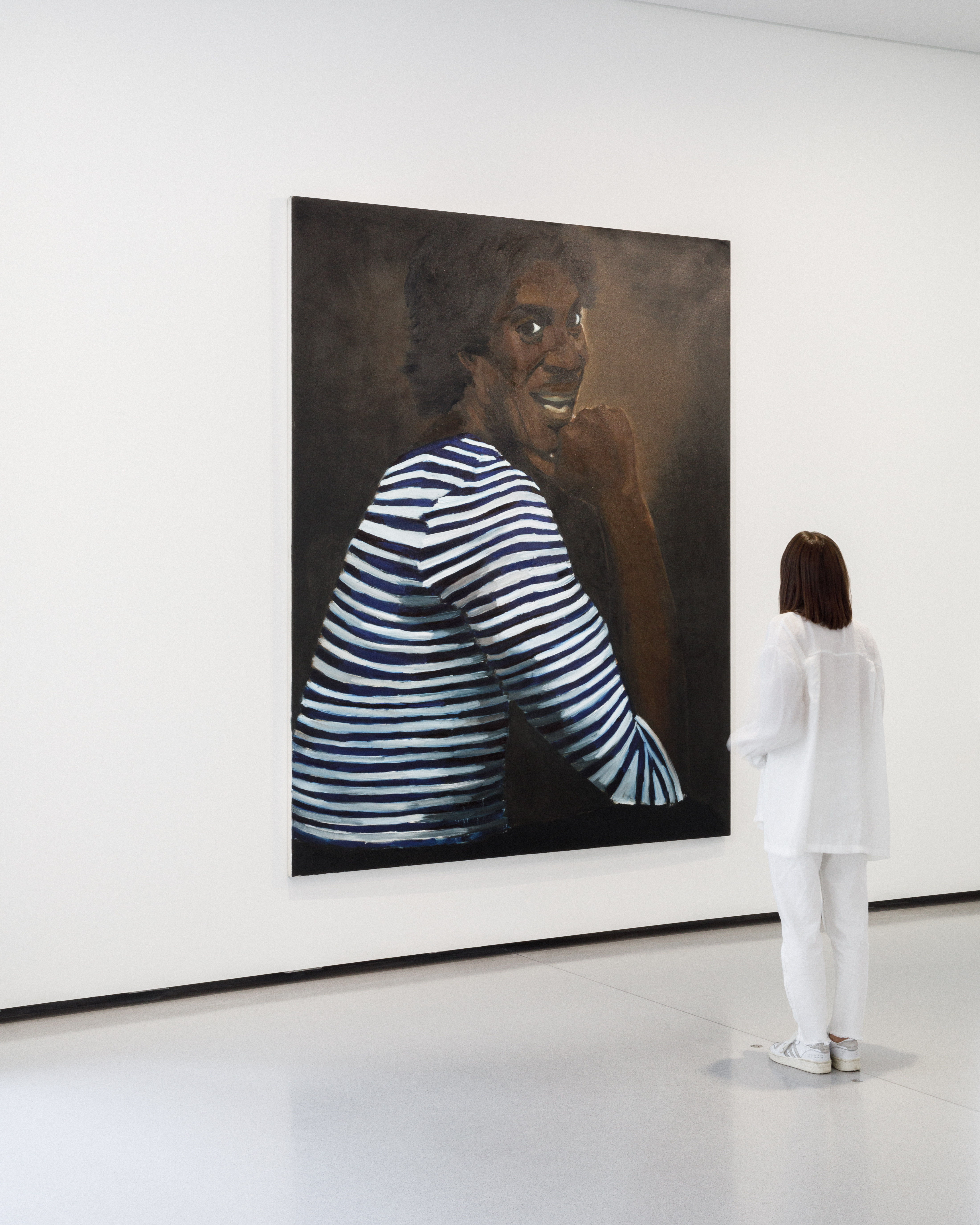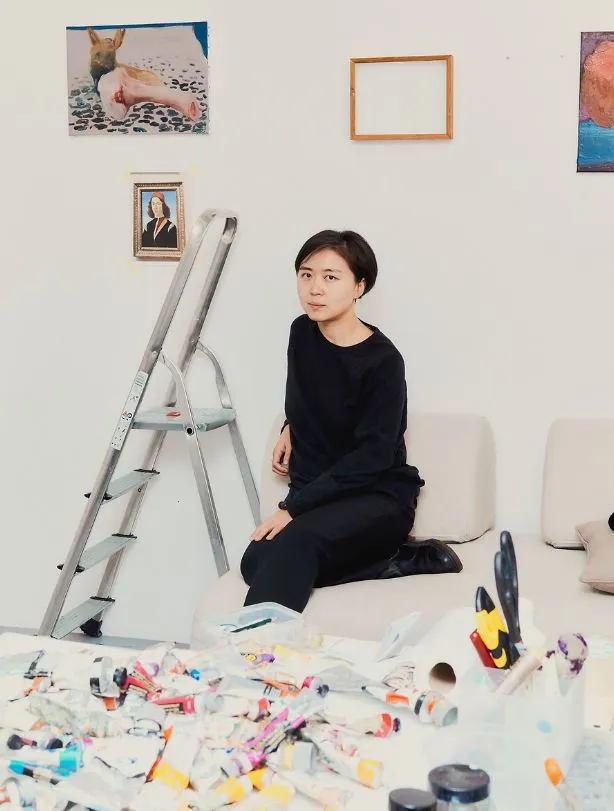Tabouret / Cheng / Yiadom-Boakye / Doig / Dumas / Serpas / Marshall

The section on painting, which began with the three monumental portraits by artist Rudolf Stingel, continued throughout the galleries on the second floor and perfectly showcases the choices of the inaugural exhibition. Furthermore, the architectural features of the building are shown to their advantage: the transparency, natural light, dual-aspect views and curvature of the walls, all of which constitute the singularity of this space.
The unusual layout, mixed from the point of view of genre, origins and cultures, is open to all generations of artists: those born in the 1950s (Marlene Dumas, Thomas Schütte, Miriam Cahn and Kerry James Marshall), artists born in the late 1970s (Lynette Yiadom-Boakye), the 1980s (Florian Krewer, Xinyi Cheng, Claire Tabouret and Antonio Oba), and the 1990s (Ser Serpas).
Claire Tabouret
The painted work of Claire Tabouret draws upon photographs, personal archives and anonymous images. The figures are removed from their original setting and propelled into the heart of an enigmatic pictorial space, as is the case with this double self-portrait of the artist, wearing a “hoodie”, a genderless, banal hooded sweatshirt. In one painting, the hood is down, revealing the weariness of the head resting on the subject’s hands, leaning on a table awash with acid colours; in the other, the same hood enshrouds the androgynous, youthful face gazing incredulously at the viewer, with an electric orange halo.
Claire Tabouret (b. 1981, works in Los Angeles) is the heir to history painting and the portrait genre, and her work is inhabited by personal photographs, anonymous images, and self-portraits. She paints by superimposing thicknesses and colours, privileging fluidity and transparency, in a half-light crossed by fluorescent touches. From these strata, presences are born, whether in large group formats or in portraits with tight framing. From the “Débutantes” of 2014 with their old-fashioned dresses to the confrontation of bodies in “Born in Mirrors” (2019), to the eccentric gathering in Les Insoumis or the disturbing group portrait Les Veilleurs (presented in “L'Illusion des Lumières”, Palazzo Grassi, 2014-2015), for the artist, painting is a “way of condensing the image in order to extract an internal light, a tenuous clue.”
Xinyi Cheng
While observing her entourage as they go about their daily lives, Xinyi Cheng captures a movement or a face, tightens the frame on a gesture and often works on a painting from personal photographs. We can see a woman, a cigarette at her lips, her face shrouded in the glow of a lighter; a hand protecting a match whose incandescence seems to pierce the canvas; a bearded man turning his mouth towards a trickle of water. The artist also imagines frozen, lascivious compositions, bathed in warm and cold hues, studded with accidents, bathed in a light coming from the colour itself.
Xinyi Cheng, born in China in 1989, now lives between Shanghai and Paris. In Baltimore in 2012, she experienced a “veritable revelation” when she discovered her own pictorial language, nourished by the paintings of the old masters (Bellini), figures of modernity (Monet, Degas, Picasso, etc.), as well as more contemporary artists like Francis Bacon, Gerhard Richter, and Luc Tuymans.
Lynette Yiadom-Boakye
Three figures, men and women, painted by Lynette Yiadom-Boakye, enter into a dialogue in Gallery 7, taking up and diverting the canonical formulae of the full-length portrait, the triptych, and the bust. Yiadom-Boakye’s painting is remarkable, in terms of its craftsmanship, commensurate with the masters upon whose lessons and influence she draws, but even more so in terms of the force of her gesture.The artist replaces the portraits of noble figures and effigies of the bourgeois individuals of yesteryear with anonymous, black, imaginary models, where the poses and framing are inspired by the archetypes of painting: large reclining figures, bust portraits, full-length portraits, and group portraits.
By strikingly highlighting the omission of black figures from the pictorial tradition in reverse, her work can be said to be a political act. Her compositions enshroud her figures with a certain air of mystery, they “do not share our concerns or our worries”, being “quite elsewhere”. Therefore, the spectator is called upon to co-create, through the work of their imagination, the world in which these strangely familiar faces live. Born in London in 1977 to Ghanaian parents, painter Lynette Yiadom-Boakye studied at Central Saint Martins School of Art and Design, at Falmouth College of Art and the Royal Academy School. Her portraits, “suggestions of people”, bear the influence of Manet, Goya, and Degas. Also a writer, the artist also publishes her short stories and poems in her exhibition catalogues.
Peter Doig
Red Canoe (2000) follows the discovery of Matisse’s Bathers with a Turtle, featuring large flat areas of colour, combining abstraction and figuration. Just as Matisse sought “serenity”, Doig, summing up the scene, longs for its “stability”. The actor Robert Mitchum in a bathing suit: Red Man (2017), comes from a series where the bather replaces the skier. Painting on an Island and Night Bathers (2019) are part of more recent productions.
Peter Doig, born 1959 in Edinburgh, grew up in the Caribbean and Canada, before studying in London. He now lives between London and Trinidad in the Caribbean. The immeasurable character of nature and its metaphysical power, mark his paintings. Inspired by German Romanticism, Edward Hopper, Edvard Munch, and horror films, Doig paints wild, untamed spaces, crossed by traces left by man: dwellings, canoes, silhouettes, etc. His simple vocabulary (man, boat, water, snow), painted from a reality altered by photography, endows his canvases with a certain enigmatic dimension, under their almost naive exterior. Today, a professor at the Kunstakademie Düsseldorf, Doig strives to create a dialogue between his work and that of his students, continuing the history of a school that has played a considerable role in the development of contemporary German painting.
Marlene Dumas
Marlene Dumas collects, gathers and examines images in order to interpret them and provide them with a body and voice, as in Mamma Roma (2012). This piece shows the tightly framed face of a mother, fraught with grief at the loss of her child. For her model, the artist uses actress Anna Magnani from the eponymous film by Pier Paolo Pasolini from 1962. Angels in Uniform (2012) brings to life a photograph, showing the residents of the Fondazione Stelline orphanage in Milan. The silhouettes of Stellina and Destino (2012) show, in close-up, a childhood stripped of its carefreeness. The thirty-six skulls from the “Skulls” series (2011-2015) make up an immersive memento mori.
Marlene Dumas was born in 1953 in South Africa, but now lives in Amsterdam. Her paintings and drawings, in oils and ink, are transfigured portraits, reflecting the human condition, torn between despair and ecstasy, death, and the love of beauty. The search or “theft” of images that will serve as the models for her paintings is a crucial step in the process, and sometimes results in a combination of unlikely sources for the same work or series: for example, the “Magdalena” series is inspired from fashion advertising and Christian Renaissance iconography. Sex, innocence and guilt inhabit her work, where the private sphere responds to politics, the news item to the myth, and our way of being in the world to the flow of images that now flood our daily lives. “I paint because I am a woman. […] I paint because I am a religious woman. (I believe in eternity). […] I paint because I am a dirty woman. (Painting is a messy business). […] Painting is about the trace of the human touch. It is about the skin of a surface.”
Ser Serpas
Influenced by her experiences in the spheres of NPOs and fashion, Ser Serpas (b. 1995 in Los Angeles) has made overconsumption one of the central themes of her art. Some of her anthropomorphic compositions combine piles of textiles and discarded objects, accentuating the sensuality of their interaction. Her drawings and paintings, from images found on the Internet or captured on a smartphone, also show naked, sexualized, fragmented bodies, although their identities and faces are never visible. The anatomical details, often shown from an unusual perspective, by means of the tight framing or the cell phone shot, in canvases nailed directly to the wall, compose a fragmentary and anonymous portrait of a body in transition. The use of wooden panels, or uneven canvas rectangles removed from their frames, marries the materiality of the supports with a very expressive layout. Presented as a polyptych on a wall of the gallery space, Ser Serpas’s paintings, presented for the first time at the Bourse de Commerce, merge scraps of bodies,—a palette of pale, pinkish, olive-toned, and brown flesh,—and seem to recompose a universal incarnation.
Kerry James Marshall
Born in 1955, Kerry James Marshall inserts black figures into archetypes of art history and popular culture, from which they have been traditionally excluded. His “Supermodel” series is anchored in pop culture and more specifically in the world of music with a reference to the eponymous album, released in 1992, by cult drag queen RuPaul. Revisiting the icons from the history of classical painting, notably with Untitled (2012), Marshall revises the Venuses of the Renaissance with his large reclining figures, taking up most of the composition. Here, we have a naked man, in socks, lying on a fur bedspread, holding the Pan-African flag in front of his genitals, illuminated by the icy whiteness of the sheets and a pillow on the bed. He resembles a new Olympia and plays with the codes of Manet’s famous painting. Growing up in Los Angeles, Kerry James Marshall witnessed the race riots of the summer of 1965. In response to the violence, the African-American emancipation movements that developed had a lasting effect on him. By choosing to paint black figures in large formats, Marshall gives black bodies a place in art history. Taking literally the application of a single adjective to plural complexions, he accentuates the “blackness” of the skin by pigments such as iron oxide, magnifying, in scenes with rich colours, the notion and representation of “black beauty”. Author of his canon, he unites the tradition of Western historical painting with that of African painting, present in the technique and palette. Marshall has taught in a number of important universities and is recognized as having paved the way for engagé painters, like Lynette Yiadom-Boakye. The artist now lives and works in Chicago.
